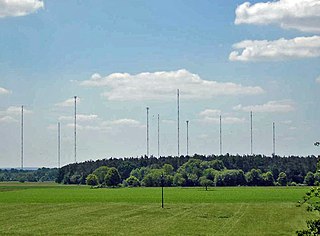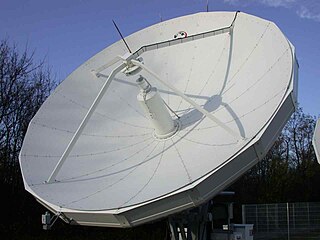
An Earth observation satellite or Earth remote sensing satellite is a satellite used or designed for Earth observation (EO) from orbit, including spy satellites and similar ones intended for non-military uses such as environmental monitoring, meteorology, cartography and others. The most common type are Earth imaging satellites, that take satellite images, analogous to aerial photographs; some EO satellites may perform remote sensing without forming pictures, such as in GNSS radio occultation.
The ITU Radio Regulations (RR) is a basic document of the International Telecommunication Union (ITU) that regulates on law of nations scale radiocommunication services and the utilisation of radio frequencies. It is the supplementation to the ITU Constitution and Convention and in line with the ITU International Telecommunication Regulations (ITR). The ITU RR comprise and regulate the part of the allocated electromagnetic spectrum from 9 kHz to 300 GHz.

A ground station, Earth station, or Earth terminal is a terrestrial radio station designed for extraplanetary telecommunication with spacecraft, or reception of radio waves from astronomical radio sources. Ground stations may be located either on the surface of the Earth, or in its atmosphere. Earth stations communicate with spacecraft by transmitting and receiving radio waves in the super high frequency (SHF) or extremely high frequency (EHF) bands. When a ground station successfully transmits radio waves to a spacecraft, it establishes a telecommunications link. A principal telecommunications device of the ground station is the parabolic antenna.

A satellite navigation or satnav system is a system that uses satellites to provide autonomous geopositioning. A satellite navigation system with global coverage is termed global navigation satellite system (GNSS). As of 2024, four global systems are operational: the United States's Global Positioning System (GPS), Russia's Global Navigation Satellite System (GLONASS), China's BeiDou Navigation Satellite System (BDS), and the European Union's Galileo.

Fixed-satellite service is – according to article 1.21 of the International Telecommunication Union's (ITU) Radio Regulations (RR) – defined as A radiocommunication service between earth stations at given positions, when one or more satellites are used; the given position may be a specified fixed point or any fixed point within specified areas; in some cases this service includes satellite-to-satellite links, which may also be operated in the inter-satellite service; the fixed-satellite service may also include feeder links for other space radiocommunication services.
The earth is constantly monitored by several satellites operating in the earth exploration-satellite service (EESS) or space research service (SRS). These artificial satellites have onboard space radio stations from which they gather data. The data is transmitted back to earth via feeder links. This article lists a number of current active Earth observation satellites and their downlink transmission frequencies.
An amateur radio satellite is an artificial satellite built and used by amateur radio operators. It forms part of the Amateur-satellite service. These satellites use amateur radio frequency allocations to facilitate communication between amateur radio stations.

Inter-satellite service is – according to Article 1.22 of the International Telecommunication Union's (ITU) Radio Regulations (RR) – defined as A radiocommunication service providing links between artificial satellites.

Standard frequency and time signal service is, according to Article 1.53 of the International Telecommunication Union's (ITU) Radio Regulations (RR), "A radiocommunication service for scientific, technical and other purposes, providing the transmission of specified frequencies, time signals, or both, of stated high precision, intended for general reception".

A feeder link is – according to Article 1.115 of the International Telecommunication Union´s (ITU) ITU Radio Regulations (RR) – defined as:
A radio link from an earth station at a given location to a space station, or vice versa, conveying information for a space radiocommunication service other than for the fixed-satellite service. The given location may be at a specified fixed point, or at any fixed point within specified areas.

Maritime mobile-satellite service is – according to Article 1.29 of the International Telecommunication Union's Radio Regulations (RR) – "A mobile-satellite service in which mobile earth stations are located on board ships; survival craft stations and emergency position-indicating radiobeacon stations may also participate in this service", in addition to serving as navigation systems.

Mobile earth station is – according to Article 1.68 of the International Telecommunication Union's (ITU) ITU Radio Regulations (RR) – defined as "An earth station in the mobile-satellite service intended to be used while in motion or during halts at unspecified points."

A land earth station is – according to Article 1.70 of the International Telecommunication Union's (ITU) ITU Radio Regulations (RR) – defined as "An earth station in the fixed-satellite service or, in some cases, in the mobile-satellite service, located at a specified fixed point or within a specified area on land to provide a feeder link for the mobile-satellite service."

Ship earth station is – according to Article 1.78 of the International Telecommunication Union's (ITU) ITU Radio Regulations (RR) – defined as "A mobile earth station in the maritime mobile-satellite service located on board ship."

Land mobile earth station is – according to Article 1.74 of the International Telecommunication Union's (ITU) ITU Radio Regulations (RR) – defined as "A mobile earth station in the land mobile-satellite service capable of surface movement within the geographical limits of a country or continent."

Coast earth station, also called the coast earth radio station is – according to article 1.76 of the International Telecommunication Union's (ITU) ITU Radio Regulations (RR) – defined as "An earth station in the fixed-satellite service or, in some cases, in the maritime mobile-satellite service, located at a specified fixed point on land to provide a feeder link for the maritime mobile-satellite service." Each radio station shall be classified by the service in which it operates permanently or temporarily.

Broadcasting-satellite service is – according to Article 1.39 of the International Telecommunication Union's (ITU) Radio Regulations (RR) – defined as «A radiocommunication service in which signals transmitted or retransmitted by space stations are intended for direct reception by the general public. In the broadcasting-satellite service, the term “direct reception” shall encompass both individual reception and community reception.»

Space radio system is – according to article 1.110 of the International Telecommunication Union's (ITU) ITU Radio Regulations (RR) – defined as «Any group of cooperating earth stations and/or space stations employing space radiocommunication for specific purposes.»

Satellite radio system is – according to article 1.111 of the International Telecommunication Union's (ITU) ITU Radio Regulations (RR) – defined as «A space system using one or more artificial earth satellites.»

Aircraft earth station is – according to Article 1.84 of the International Telecommunication Union's (ITU) ITU Radio Regulations (RR) – defined as "A mobile earth station in the aeronautical mobile-satellite service located on board an aircraft."
This page is based on this
Wikipedia article Text is available under the
CC BY-SA 4.0 license; additional terms may apply.
Images, videos and audio are available under their respective licenses.
















